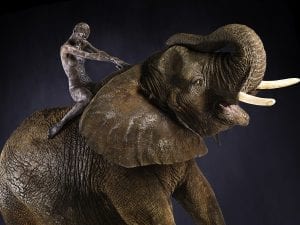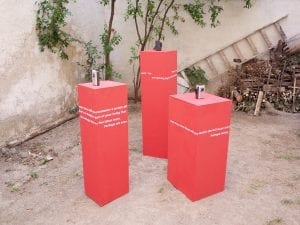Nu’a Bön is a Hawai’i-born artist and shaman trained in the USA, South America and China. The generosity of patrons allows him to explore sacred places and sites of human conflict to create and offer Ìcaros (prayer/paintings) in the sumi-e style.
A: Could you describe the ways in which spirituality has influenced your work; do you see painting as a vehicle for prayer?
NB: Whether it is through painting, or photography, or sound art (a full installation of my work uses all these forms) spirituality is at the core of my work. I produce what I refer to as icaro, from the Quechua word for blowing smoke to heal, as I studied with indigenous medicine people in the Peruvian Andes and in Amazona. Icaros there are typically medicine songs of healing and protection that are often accompanied with a visual pattern on cloth or pottery that serves in a way as a musical score. Cloth with these patterns are drawn or embroidered on healing blankets or mats that are used in healing ceremonies. When I am commissioned to engage in a project by a patron we discuss a place or an historical event that resonates with both of us as something that was or is unsettling and could use some assistance or healing in a way, usually in the form of an icaro as a prayer painting.
I travel to different sites across North America in a bespoke expedition vehicle that I use as a mobile art studio, to complement the studio I have in Providence, Rhode Island on the east coast of the U.S. In 2016, I traversed the continent eight times from the east coast to the west coast and back, from the US/Canada border to the border with Mexico and the Gulf Coast, visiting ancient sacred Native American sites, sites of the massacres of Native Americans and slave populations, old and new battlefields from the Indian Wars from Wounded Knee in South Dakota to Sacred Stone Camp in North Dakota, the Civil War battlefields, and, as an example the war on LGBT people as with the Pulse nightclub in Orlando, Florida.
My shaman training recognises the quantum understanding that all matter, all of life, is energy and that energy does not disappear. From a sacred understanding of energy there is no use for concepts like good or evil, there is just life energy that in the course of our passage in the continuum between birth to death flows like water or is sometimes stuck because of some obstacle.
To make things simple, I lay linen canvas on the ground of different sites, I invite whatever energies or spirits are there to play on or to speak through canvas and acrylic ink, letting it flow and take whatever course it wants to take. I recall something a shaman near Lake Titicaca told me, that spirits are stuck in a place, prevented from going to where they need to go next because they may be unknown at death or have not been properly honoured.
A: Is your work internationally and socially concerned, and to what extent is this responding to your personal experience?
NB: Energy has no particular nationality nor culture. To take on work as a facilitator for helping it become unstuck during its transition, at least in my way, appeals to my sense that we all have to do the best we can to help each other out. Personal experience? I have loved and lost.
A: Do you feel that academia and education is essential to your artistic progression?
NB: I once was a university lecturer, a professor in American terms, when I taught graduate and post-graduate courses in China. To those on the inside, we know that the university is more like an empire than a democracy, more about conforming to a rigid mold than about bettering humankind. I no longer teach.
A: Would you say that physical structures have provided an aesthetic foundation for your work?
NB: An artist must understand material and must have the tools (such as a brush or a studio or a way to keep canvases from sticking to each other) for making this material as magic as is possible. At one time I focused on geometric mandala forms on large paintings, prints, and multi-media projections, today my work has a different form but in a way it’s all the same to me. Visual artists deal with light and the absence of light, spacial relationships within human bounds, and the psychology of colour, it’s our common lingua franca. Somehow though it all comes together to appeal to my aesthetic or another sense, otherwise I will do what I have done on occasion, I take the paintings far out to a desert, build a teepee structure, and burn them.
A: Given the variation in your choice of material, what would you argue is the most consistent and important theme?
NB: Flow.
A: What do you have lined up for the forthcoming year?
NB: I am starting soon on a new cycle of icaro/paintings involving heiau, ancient stone temples in Hawaii where I’m from. I’m still in the research phase as many of these temples are either buried within the modern city of Honolulu, in someone’s backyard, or have been relocated. There are also many more sites within the US Mainland that I have to visit or revisit before the winter sets in and it becomes difficult to work outside.
Credits:
1. Leina a Ka’uhane, 2017. Acrylic ink on linen, 170cm x 254cm.





